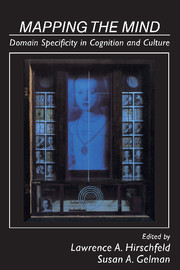Book contents
- Frontmatter
- Contents
- List of contributors
- Preface
- Part I Overview
- Part II The origins of domain knowledge: Biology and evolution
- Part III The origins of domain knowledge: Conceptual approaches
- Part IV Are domains theories?
- 10 The theory theory
- 11 Thinking by children and scientists: False analogies and neglected similarities
- 12 Core domains versus scientific theories: Evidence from systematics and Itza-Maya folkbiology
- 13 Essentialist beliefs in children: The acquisition of concepts and theories
- Part V Domains across cultures and languages
- Part VI Implications for education
- Author index
- Subject index
10 - The theory theory
Published online by Cambridge University Press: 04 August 2010
- Frontmatter
- Contents
- List of contributors
- Preface
- Part I Overview
- Part II The origins of domain knowledge: Biology and evolution
- Part III The origins of domain knowledge: Conceptual approaches
- Part IV Are domains theories?
- 10 The theory theory
- 11 Thinking by children and scientists: False analogies and neglected similarities
- 12 Core domains versus scientific theories: Evidence from systematics and Itza-Maya folkbiology
- 13 Essentialist beliefs in children: The acquisition of concepts and theories
- Part V Domains across cultures and languages
- Part VI Implications for education
- Author index
- Subject index
Summary
This is a book about domain-specific cognition – the proposal that at least some human conceptual abilities are specialized for some types of contents and not for others. In this chapter we address the development of a single domain: everyday understanding of the mind. We suggest that this development is best understood as the formulation of a succession of naive theories. Moreover, this “theory theory” can help to characterize cognitive domains more generally and to explain domain-specific development. Our chapter, therefore, joins company with a number of recent discussions drawing parallels between theory change in science and cognitive development (Carey, 1985, 1988; Gopnik, 1984, 1988; Karmiloff-Smith & Inhelder, 1974; Keil, 1987; Wellman, 1985, 1990).
Theory of mind
In the past five years there has been an explosion of interest in children's early understanding of the mind (Butterworth, Harris, Leslie & Wellman, 1991; Astington, Harris, & Olson, 1988; Frye & Moore, 1991; Whiten, 1991). The research tackling this question has come to be called “children's theory of mind.” This title reflects a leading explanatory position among investigators in this area. According to this position, our everyday conception of the mind is an implicit naive theory; children's early conceptions of the mind are also implicit theories, and changes in those conceptions are theory changes. We refer to this explanatory position as the “theory theory.”
If the theory theory has any content, it should be falsifiable. It should lead to empirical predictions about the course of development, and these predictions should be different from those of alternative accounts.
- Type
- Chapter
- Information
- Mapping the MindDomain Specificity in Cognition and Culture, pp. 257 - 293Publisher: Cambridge University PressPrint publication year: 1994
- 328
- Cited by



